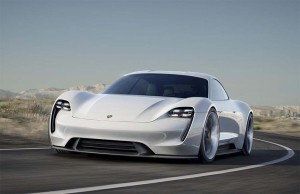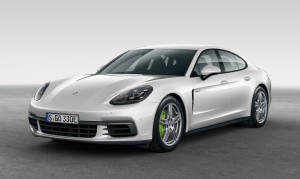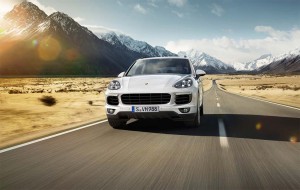
Porsche is moving forward with its newest electric vehicle, the Mission E, as it expands its electrification efforts to half of its line-up.
It will be another year before Porsche’s first pure battery-electric vehicle, the Mission E, finally reaches market, but the German sports car brand already is laying out big plans to electrify.
Fully half of all Porsches will use some form of battery power by 2023, according to a presentation by Porsche Cars North American CEO Klaus Zellmer. That is expected to include not only the hybrids and plug-in hybrids currently in the line-up, but also additional BEVs like the Mission E. Porsche officials have also suggested they will eventually electrify even such classic core models as the iconic 911.
While such a move might be a stretch for traditional Porsche buyers, the brand has begun bringing in younger buyers who are more open to experimentation, said Zellmer, speaking at the annual Automotive News World Congress. Nearly 80% of the customers who are signing up for the new Porsche Passport subscription service “have not owned a Porsche before,” he noted.
Porsche is not entirely new to electrification. In fact, founder Ferdinand Porsche’s first car, the Loehner-Porsche Mixt, of a century ago, was a very primitive plug-in hybrid. It even had wheel-mounted motors, a concept just being tinkered with again today
The German carmaker now offers a handful of hybrid and plug-in models, including versions of the Cayenne crossover-utility vehicle and the coupe-like Panamera sedan. In fact, the brand’s 918 Spyder supercar used a twin-motor plug-in drive system to deliver a combined 889 horsepower.
(Marchionne hints at plans for a battery-electric supercar. Click Here for the details.)
Porsche has the benefit of accessing technology developed by its parent, Volkswagen AG, and several of VW’s high-line brands, notably Audi and Lamborghini, are working on the sort of high-performance systems that Porsche would need, in particular.
Of course, it won’t be the only automaker, moving forward, planning a major push into electrification. VW has, for one, said it wants to have 40 BEV models on the market by 2025. General Motors is targeting 20 by 2023. On the high-line side, Infiniti this week announced it will begin to go “all-electric,” with the exception of its largest SUVs, starting in 2019.
High-performance brands are also jumping in, hoping to benefit from the instant torque offered by electric motors. Aston Martin is getting ready to start production of the limited-edition RapidE and has broadly hinted of bringing out an electric version of the DBX sport-utility vehicle it is developing.
Even Ferrari is giving serious thought to electrification. Like the Porsche 918, it used a Formula One-derived hybrid system for its La Ferrari hypercar and, as TheDetroitBureau.com first reported this week, CEO Sergio Marchionne is giving serious thought to an all-electric sports car with the prancing pony logo.
Performance brands can’t ignore the numbers that Tesla has delivered. Its Model S P100D can launch from 0 to 60 in about 2.8 seconds, roughly matching the acceleration of the Dodge Demon, when equipped with optional Ludicrous Mode. And Tesla recently unveiled its second-generation Roadster which is expected to be even faster.
That said, Tesla’s existing models do face some limitations: pedal-to-the-metal launches not only draw down batteries in a hurry but tend to quickly overheat both battery pack and motors. The P100D can, at best, muster a lap or two on most race tracks.
(Click Here to see Porsche’s four new models it rolled out.)
Porsche is promising its Mission E will perform like a true sports car, however. But will customers accept it?
In an interview with British car magazine AutoCar last November, Porsche’s global CEO Oliver Blume said the marque has gotten “very good feedback” for the Panamera plug-in. But the question is whether they’ll accept electrification of the iconic 911.
“With the 911, for the next 10 to 15 years, we will still have a combustion engine,” Blume said. “We have combustion engines, then plug-ins as intermediaries, then full EV later on. The future concept of 911 will have plug-in built in, but it’s not decided yet if we offer it: 911 is a core business and we need it to be a pure sports car. When customers want it to be electric, we can be ready.”
Over the coming years, attitudes may change, in part, because Porsche expects to draw in some very different customers. Not only will that be a matter of the passage of time, but also it will reflect changes in the company’s marketing strategy.
The Porsche Passport program is one example. It offers customers the opportunity to sign up at two different monthly tiers, each allowing a driver to swap between a list of select vehicles as often as once a day. Want a 911 during the week? Swap it out on Friday for a Panamera or Cayenne so you have room to take the family off on a trip.
Those signing up for Passport “are much younger than our average customer,” PCNA CEO Zellmer said during his Detroit speech, adding that “78% of members in Porsche Passport have not owned a Porsche before, currently do not own a Porsche. So the conquest rate is close to 80%.”
(To see how the Mission E causes problems for Tesla and the Model 3, Click Here.)
The program currently is limited to the Atlanta area but could soon expand to other markets. And it may be part of a more dramatic shift in not only how but what future Porsche customers will drive.



I wonder if they’ll have a boxer battery?